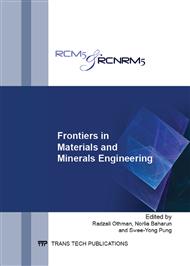p.151
p.159
p.164
p.171
p.177
p.184
p.190
p.199
p.205
The Effect of FeSO4 Containing Solution on Microbiological Influenced Corrosion by Desulfovibrio Baculatus Bacteria on API 5L X65 Steel
Abstract:
Microbiological Influenced Corrosion (MIC) is a common cause of metallic failure and currently known as one of the important case in pipeline failure. Otherwise it was often found also in cooling water system, in the equipment of pulp and paper, and oil and gas industry. Certain bacteria have a wide range of life condition and can be found anywhere. Sulfate Reducing Bacteria (SRB) is a bacteria that was frequently found as a cause of corrosion in steel surface by creating pits. In this research, the corrosion test was done by using one species of SRB which is Desulfovibrio Baculatus. The water that contains bacteria growth medium (API Sulfate Broth) is used as a media for API 5L X65 steel corrosion test. Sulfate for the growing of SRB was added in the solution in 8.56 , 17.12 , 42.8 and 85.64 ppm concentration, and the immersion test was done during 1,7,14,21 days. The source of sulfate is FeSO4.7H2O, and this compound was considered also as a source of Iron (II). The result shows that the weight loss is increase with increasing of immersion period. Between 7-14 days of immersion time, the increase of weight loss that present a corrosion rate attains the highest condition and decrease again after a longer time of immersion period. Morphologic observation reveals that the corrosion product consists of Iron Oxide and biological deposits that were formed at the beginning of corrosion test, and continuing with the formation of Iron Sulfide at a longer period of immersion. The formation of Iron Sulfide was associated with the increase of corrosion rate. Keywords: MIC, SRB, Desulfovibrio Baculatus, Immersion, FeSO4 content.
Info:
Periodical:
Pages:
177-183
Citation:
Online since:
November 2013
Authors:
Keywords:
Price:
Сopyright:
© 2014 Trans Tech Publications Ltd. All Rights Reserved
Share:
Citation:


